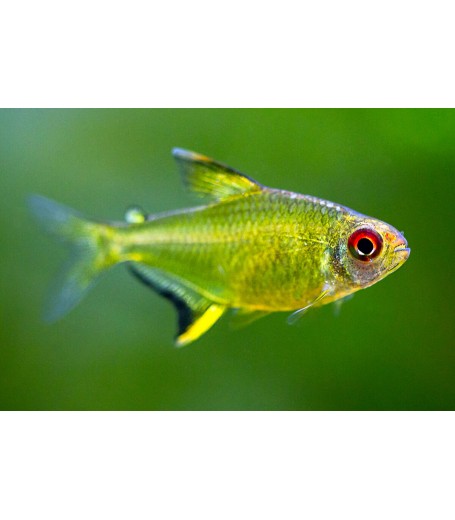LEMON TETRA
- RM4.00
Lemon tetras are a lovely freshwater fish that can add a special pinch of color to any aquarium. They’re also quite active and easy to care for.
But for whatever reason, this species is often underrated in the fishkeeping community. We can’t figure it out, because not only do we love them, we know a bunch of other owners who do as well.
If you’re thinking about giving this species a chance, read on to learn everything you need to know about lemon tetra care. You’ll learn about their diet, size, tank mates, behavior, and more!
scientific name: Hyphessobrycon pulchripinnis
| Category | Rating |
| Care Level: | Easy |
| Temperament: | Calm but active swimmers |
| Color: | Golden or yellow with slightly transparent bodies |
| Lifespan: | 6–8 years |
| Size: | ~2 inches |
| Diet: | Live or frozen brine shrimp, mosquito larvae, and bloodworms |
| Family: | Characidae |
| Minimum Tank Size: | 20 gallons |
| Tank Set-Up: | Tropical freshwater |
| Compatibility: | Compatible with other small community fish |
Disease
Lemon tetras are susceptible to common aquarium-related diseases and infections. Keep an eye out for the following conditions and treat the fish accordingly:
- Anchor Worm — Anchor worms need to be removed from the affected area with tweezers. Treat the area with an antibiotic ointment once the area has been dewormed.
- Dropsy — An accumulation of water in the stomach causes dropsy. Dropsy should be treated with antibiotics and adding a saline solution to the water.
- Mouth Fungus — Mouth fungus will eat away at the fish’s jaw. Treat mouth fungus with antibiotics until all signs of the fungal infection are gone.
Tank Conditions
Keep the lemon tetra tank within the following water parameters at all times to ensure optimal health.
- Ideal water type: Lemon tetras thrive in tropical freshwater. Treating tap water with a dechlorinator is ideal for use in a lemon tetra tank. Using tap water will also keep maintenance costs down when performing regular water changes.
- Tank size: Lemon tetra fish are tiny but highly active swimmers and therefore require plenty of room in an aquarium. A 20-gallon fish tank or bigger is ideal for lemon tetras. Ensuring the tank is big enough for the fish species allows aquarists to decorate the tank with the desired plants and accessories that the tetra requires and leave plenty of swimming space.
- Ideal water temperatures: The perfect water temperature in a lemon tetra tank is 720 to 820 Fahrenheit. As you can see, the temperature range is very broad and gives fishkeepers the chance to pair the lemon tetras with more temperature-specific fish. Keeping the water temperature between 75° to 78.8° Fahrenheit will encourage tetra fish to spawn.
- Substrate: Delicate sand substrates are ideal for lemon tetra fish tanks. However, a fine gravel substrate will also work well. Adding fine sand to the bottom of the tank mimics the substrate at the bottom of the South American rivers that lemon tetras inhabit in the wild.
- Decorations and plants: Decorate the substrate with bits of driftwood and natural wood accessories to replicate the tetra’s natural habitat. Avoid adding plastic plants and accessories to the tank as the decorations can damage the fish.
- Water pH levels: Aquariums with a pH level between 5.5 to 8.0 are perfect for lemon tetra fish. The flexible pH level ranges are a reason why lemon tetras are great tank mates for fussy fish.
- Filters and bubblers: Using a standard water filtration system is more than enough for lemon tetra tanks. Fitting the aquarium with a bubbler is not a good idea in lemon tetra tanks. Lemon tetras prefer swimming in slow-flowing water, so bubblers bother the tetra greatly.
Tank Mates
Lemon tetra fish are very peaceful and easy-going fish. Tetras are shoaling fish that display schooling behavior. Keeping lemon tetra fish with neon tetras and other tetra species is ideal.
Dominant and aggressive fish like cichlids are not appropriate in lemon tetra tanks as the cichlids will bite and nip at the tetras, causing physical damage and emotional distress.
Bottom-dwelling fish are also great tank mates as the bottom dwellers will not get in the lemon tetra’s way.
Here are some great lemon tetra tank mates to consider:
- Danio — Danio fish are hardy and tolerant of varying tank conditions, much like lemon tetras.
- Rasbora — Rasbora fish are related to barbs, danios, goldfish, and koi. Rasbora fish need to be kept in shoals of 10 or more fish.
- Corydoras — Corydoras are also known as cory catfish. Cory catfish are slow, bottom-dwelling fish that will not get in the way of the lemon tetra’s speeding around the tank.
Diet and Feeding
In the wild, lemon tetra fish feed on crustaceans, plant matter, and invertebrates. Bloodworms, shrimp brine, and mosquito larvae are great alternatives for aquarium-grown lemon tetras.
High-quality protein-rich fish food flakes are also good for feeding lemon tetra in home aquariums.
Lemon tetra should eat two or three times per day, and the majority of their diet should come from fish food flakes and pellets, with the addition of live or frozen food three times per week.
Reviews
There are no reviews for this product.



